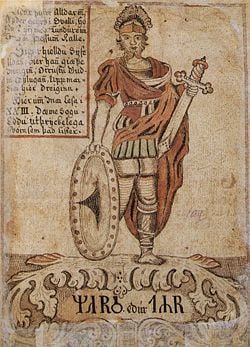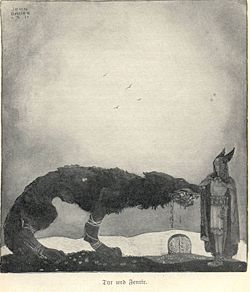Difference between revisions of "Tyr" - New World Encyclopedia
Scott Dunbar (talk | contribs) (Imported, credited article and added categories) |
Scott Dunbar (talk | contribs) (Claimed) |
||
| Line 1: | Line 1: | ||
| + | {{Claimed}} | ||
[[Image:IB 299 4to Tyr.jpg|right|250px|thumb|Týr, depicted here with both hands intact, is identified with [[Mars (god)|Mars]] in this illustration from an [[18th century]] [[Iceland]]ic manuscript.]] | [[Image:IB 299 4to Tyr.jpg|right|250px|thumb|Týr, depicted here with both hands intact, is identified with [[Mars (god)|Mars]] in this illustration from an [[18th century]] [[Iceland]]ic manuscript.]] | ||
Revision as of 21:27, 13 February 2007

Tyr (Old Norse: Týr) is the god of single combat and heroic glory in Norse mythology, portrayed as a one-handed man. In the late Icelandic Eddas, he is portrayed, alternately, as the son of Odin (Prose Edda) or of Hymir (Poetic Edda), while the origins of his name and his possible relationship to Tuisto (see Tacitus' Germania) suggest he was once considered the father of the gods and head of the pantheon. Corresponding names in other Germanic languages include Tyz (Gothic), Ty (Old Norwegian), Ti (Old Swedish), Tiw, Tiu, Tio, and Tig (Old English) Týr (Modern Icelandic and Faroese), Ziu and Zio (Old High German), and possibly, even Teiw (in lith. tevas, tevs - father; dievas, deive - god) in Proto-Germanic, ie. the Negau helmet.
Origins
The name Tyr meant "god" (cf. Hangatyr, the "god who hung" [referring to when Odin hung in a tree for nine days]) as one of Odin's names; probably inherited from Tyr in his role as judge—compare with the Irish "Midir", the judge par excellence) and goes back to a Proto-Germanic Tîwaz, earlier Teiwaz, continuing Proto-Indo-European *deywos "god", a word related to but distinct from the name of the sky-god Dyeus (in lith. both Dyeus and Deywos has the same meaning Dievas or god, but Deives means the goddess).
It should be noted however, that direct reference between Tyr/Teiw and "leader of the Gods" may be debatable. While the Proto-Indo-European origins of the term is common wisdom, "Dyaus" , "Deywos" and "Devas" have always been used in a generic way to refer to the gods. "Dyaus-pater" which literally means the "father of Gods" later transformed through common uses in ancient Greece and Rome into "Zeus-pater" and then to "Jupiter" have been applied to Zeus/Jupiter and to Woden/Odin (Nordic). While youthful-"looking" gods such as Tyr and Vedic counterparts such as Indra have been linked to similar roles as leader, this was primarily done during times of war. Woden or Odin is generally accepted as the all-seeing father of the Aesir. (Dr. Bik DasGupta, 2006)
The oldest attestation of the god is Gothic Tyz (Vienna cod. 140), though the "Teiw" found on the Negau Helm may very well be a direct reference to the God, rather than a god, and predates the Gothic (and indeed runic script) by several centuries.
Tîwaz was overtaken in popularity and in authority by both Odin and Thor at some point before the Migration Age. In terms of his relationship to Thor, it is clear that Tyr's linguistic cognates in other Indo-European pantheons were the original possessors of the thunder, eg. Zeus, and in some cases ultimately passed that attribute on to another god, eg. Dyaus to Indra. In Eddaic myth, and apart from that aspect of Thor named Magni (meaning "spiritual strength", as in "with all my might and main"), only Tyr's strength is ever compared to Thor's.
There is sketchy evidence of a consort, in German named Zisa: Tacitus mentions one Germanic tribe who worshipped "Isis", and Jacob Grimm pointed to Cisa/Zisa, the patroness of Augsburg, in this connection. The name Zisa would be derived from Ziu etymologically, in agreement with other consorts to the chief god in Indo-European pantheons, e. g. Zeus and Dione.
Tyr in the Edda
According to the Edda, at one stage the gods decided to shackle the wolf Fenrisulfr (Fenris), but the beast broke every chain they put upon him. Eventually they had the dwarves make them a magical ribbon called Gleipnir from such items as a woman's beard and a mountain's roots. But Fenris sensed the gods' deceit and refused to be bound with it unless one of them put his hand in the wolf's mouth. Tyr, known for his great courage, agreed, and the other gods bound the wolf. Fenris sensed that he had been tricked and bit off the god's hand. Fenris will remain bound until the day of Ragnarök.
As a result of this deed, Tyr is called the "Leavings of the Wolf". As the wolf is a frequent metaphor for the all-devouring grave, and with the well-known Eddaic adage "Cattle die, kinsmen die…" in mind, the meaning of this by-name becomes clear. Tyr is glory, the name undying, which shall endure after one's death. And indeed, at the root of his name and the basic Indo-Germanic idea of godhood we find the meaning of "heavenly radiance". Various Germanic words that spring from this same root are the Anglo-Saxon tir (glory), the Old High German Ziori (splendour), and the Old Norse tiv (god, hero).
According to the Prose version of Ragnarok, Tyr is destined to kill and be killed by Garm, the guard dog of Hel. However, in the two poetic versions of Ragnarok, he goes unmentioned; unless one believes that he is the "Mighty One".
In the Lokasenna, Tyr is taunted with cuckoldry by Loki, maybe another hint that he had a consort or wife at one time.
Other traces
Tyr/Tiw had become relatively unimportant compared to Odin/Woden in both North and West Germanic, and specifically in the sphere of organized warfare. Traces of the god remain, however, in Tuesday ("Tiw's day"), named after Tyr in both the North and the West Germanic languages (corresponding to Martis dies, dedicated to the Roman god of war and the father-god of Rome, Mars) and also in the names of some plants: Old Norse Týsfiola (after the Latin Viola Martis), Týrhialm (Aconitum, one of the most poisonous plants in Europe whose helmet-like shape might suggest a warlike connection) and Týviðr, "Tý's wood", in the Helsingor dialect Tistbast, modern Swedish Tibast (the Daphne mezereum, a shrub which blooms before the leaves appear in spring). The Swedish forest Tiveden may also be named after Tyr, or reflecting Tyr as a generic word for "god" (i.e. the forest of the gods). In Norway the parish and municipality of Tysnes are named after the god.
Tyr rune
The t-rune ᛏ is named after Tyr, and was identified with this god., the reconstructed Proto-Germanic name is Tîwaz (lith. Tevas - father, Dievas or Deivas - god). The rune is sometimes also referred to as Teiwaz, or spelling variants.
The rune was also compared with Mars as in the Icelandic rune poem:
|
|
Modern popular culture
Although representations of Tyr are less common than those of Thor, Odin or Loki, Tyr is often referenced or appears as a warrior figure in many modern depictions, particularly those relating to high fantasy, usually most identifiable by his missing arm and lust for battle.
Tyr has also become a character in the daily comic strip Ink Pen, by Phil Dunlap. Tyr is upset that his brother Thor has a comic book and he doesn't, so he tries to get a job as the mascot for a company. However, Tyr can't find work, mainly due to his "male pattern baldness, atrocious personal hygiene, and uncontrollable anger."
External links
- Grimm's Teutonic Mythology (English translation, chapter 9)
- Tyr in Germanic Religion
- Týr and Zisa by William Bainbridge
- Týr Official Site A Viking Metal Band from The Faroe Islands
Credits
New World Encyclopedia writers and editors rewrote and completed the Wikipedia article in accordance with New World Encyclopedia standards. This article abides by terms of the Creative Commons CC-by-sa 3.0 License (CC-by-sa), which may be used and disseminated with proper attribution. Credit is due under the terms of this license that can reference both the New World Encyclopedia contributors and the selfless volunteer contributors of the Wikimedia Foundation. To cite this article click here for a list of acceptable citing formats.The history of earlier contributions by wikipedians is accessible to researchers here:
The history of this article since it was imported to New World Encyclopedia:
Note: Some restrictions may apply to use of individual images which are separately licensed.

